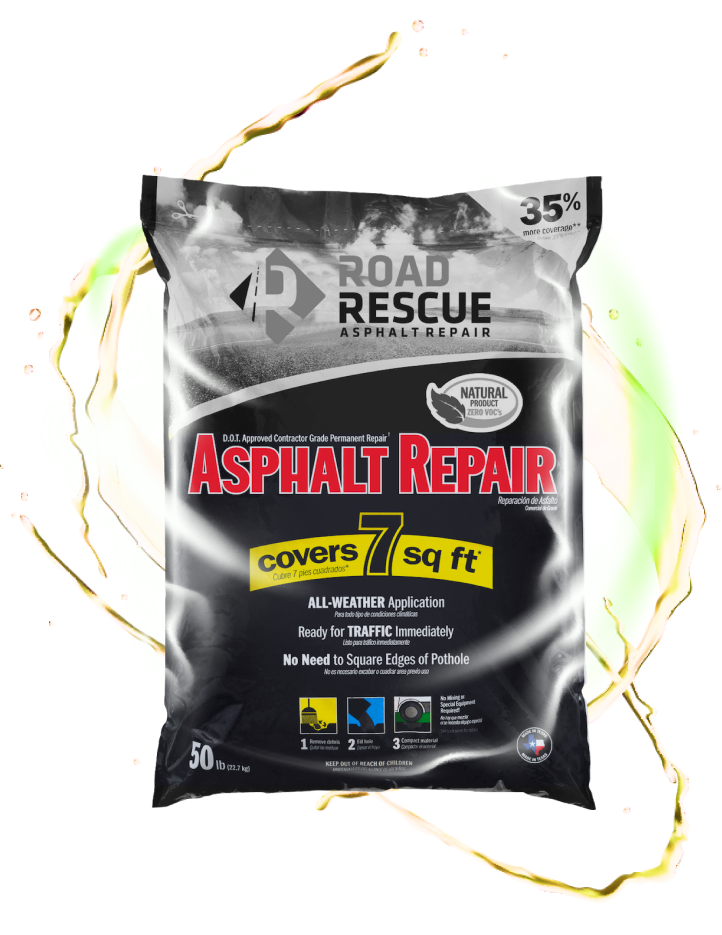Mobile Friendly Instructional
Road rescue® application Guide
Our simple Road Rescue Application Guide Steps and FAQs allow users to achieve professional and permanent results with minimal skill and no prior experience.

Permanent Fixes In 3 Simple Steps
Road Rescue® Bags
1
Sweep
Sweep and Clean the Area
2
Fill
Apply Road Rescue® Asphalt
3
Compact
Compact with Vehicle
Bags
Common Questions
Just remove loose debris or ice, then pour the material directly into the water filled hole. The asphalt will displace most of the water. Additional water will be displaced once the asphalt is compacted. Remember to leave a 1 inch crown on the repair for additional traffic. Pressure from additional traffic will gradually force any remaining moisture out of the repair, reducing the probability of freeze-thaw damage.
Road Rescue® is ready for traffic immediately after compaction. Remember to leave a 1 inch crown on top because the binding process will continue as traffic applies additional pressure.
One 50 lb. bag covers 0.6 cubic ft (compacted); 85 lbs./cubic ft.
For example, it takes one 50 lb. bag to repair a 7 ft x 1 ft x 1 inch pothole.
If you’re trying to figure out how much material you need for a project, try our Job Calculator.
Absolutely. Simply drop your bag of Road Rescue® gently onto the ground as if it were a bag of ice. The material will break free and be perfectly ready to use. Any additional clumps can be easily broken up as you spread the material.
Vibratory plate compactors are not recommended due to the varying grades of aggregate that make up the material of Road Rescue®. The smaller grade aggregates help fill small voids and crevices during compaction. The use of a vibratory plate compactor will cause the smaller aggregates to sink to the bottom of the repair, leaving those small voids and crevices unfilled on the top layers. For the best results, we recommend compacting Road Rescue® with a vehicle tire, steel roller, or pneumatic roller.
No, for the best results with Road Rescue® we recommend driving directly on the material. The weight of the car will properly compact the material. Placing a board between your tires and the material disperses the weight more unevenly and thus fails to properly compact the patch.
Yes, that’s completely normal and here’s why: Most asphalt is a manufactured mix of distilled crude oil and rock aggregate. Basically, it’s rocks coated in a tarry binder. But our native asphalt is different. Over 70 million years of heat and pressure have forced a natural bitumen binder to permeate deep inside the Anacacho limestone rocks in our asphalt. That’s why our material is dry-to-the-touch and perfectly safe to handle unlike oily manufactured alternatives. If you apply pressure, our rocks secrete that bitumen and fuse together into a dense and durable surface. Otherwise, our native asphalt rocks remain mostly dry and clean.
No, Road Rescue® has been proven to perform in temperatures ranging from sub-zero to 168° Fahrenheit and in water-filled holes. Our asphalt doesn’t depend on additives or binders that become unreliable outside a specific range of temperatures or moisture levels. And erratic weather won’t cause recently applied patches to migrate either. With Road Rescue®, you can expect fewer weather delays, less failed patches, and very little wasted material.
Yes. Just seal the bag opening tightly, and the remaining material will stay usable for up to 8 months. To ensure optimal performance, however, we recommend using the material within 3-6 months of first exposure to air. While it may be possible to “fluff up” old stale material, we can’t guarantee the longevity of the material under those circumstances.
Hand tampers are not recommended. Since Road Rescue® binds on compaction, it is best to apply as much force as possible. Using a vehicle tire, steel wheel, or pneumatic roller will allow you to achieve the best results.
Not at all. Since Road Rescue® is self-priming, our unique asphalt blend bonds tightly to the walls of the pothole without needing additional primers or tack coats.
Cold patches are made to set up as their hydrocarbon solvents evaporate. Road Rescue® is ready for traffic immediately because our rocks secrete bitumen and bind on compaction, not evaporation. This gives Road Rescue® a clear advantage over other asphalt on the market. Cold patches that rely on evaporation can take hours or days before they are ready for traffic. Drive over these patches too soon and they rut and shove, or in certain cases, fail altogether.
How to Apply
Road Rescue® Totes
1
Prep
Prep the Area
2
Fill
Apply Road Rescue®
Asphalt Repair
3
Compact
Compact Road Rescue®
Asphalt Repair
Totes
Common Questions
Each tote contains 2,350 lbs. of Road Rescue® Asphalt Repair.
Sealed 2,350 lb. totes of Road Rescue® remain fresh and usable for 1 year. Our asphalt has an extended shelf life because it resists oxidation and doesn’t contain volatile chemical additives unlike other asphalt repair materials.
Yes, our totes are equipped with a resealable spout that makes storing bulk asphalt easy, clean, and keeps your material fresh for later use. Simply cinch your tote closed using the resealable spout and the remaining material will stay workable for up to 8 months. However, for best results, we recommend using the remaining material within 3-6 months after first exposure to air.
Road Rescue® totes easily fit into most truck beds. Remove the shrink wrap and attach each of the four, high-strength loopholes to a forklift to safely maneuver the tote. Simply place the tote into the bed of your vehicle or use the resealable spout to dispense the desired amount of material.
Road Rescue® is “throw-and-roll” asphalt which means our material binds on compaction. Compacting our material with a vehicle’s tire will yield the best results. For large-scale projects, we recommend using a pneumatic roller to cover more area.
*Vibratory plate compactors are not recommended due to the varying grades of aggregate that make up the material of Road Rescue®. The smaller grade aggregates help fill small voids and crevices during compaction. The use of a vibratory plate compactor will cause the smaller aggregates to sink to the bottom of the repair, leaving those small voids and crevices unfilled on the top layers.
Each tote is made to order, shrink wrapped, and delivered directly to you on a pallet. This ensures you receive fresh bulk asphalt that’s not only easy to store, but lasts twice as long as loose bulk asphalt. Our material rivals the strength of hot mix and is easier to use than cold patch asphalt. With a resealable spout that makes transportation easy, your large-scale road repairs just got faster, cleaner, and more proactive.
Loose bulk asphalt contains hydrocarbon solvents that evaporate when exposed to air and moisture. Stored outside for extended periods of time, these solvents break down which can leave you with large quantities of unusable material. Loose bulk asphalts that rely on evaporation can take hours or days before they are ready for traffic. Driving over these materials too soon can cause your repairs to fail altogether, which requires more work and more material. Loose bulk asphalt is also notoriously messy, taking up hours of manpower to clean equipment with costly chemicals. Add these costs up and loose bulk asphalt becomes expensive, time-consuming, and a hassle to work with.
That depends on what type of asphalt repairs you need to make. While our 50 lb. bags are perfect for potholes and other small road repairs, Road Rescue® totes are designed for tackling large-scale asphalt repair projects like utility cuts, overlays, and even new road construction. If you’re trying to figure out how much material you need for a project, try our Job Calculator below.
Calculator

Road Rescue® Asphalt For All Your Repair Needs
Visit our Shop page to explore our convenient Asphalt Bags and Totes. Designed to make transportation and application of Road Rescue® Asphalt simple, easy, and hassle-free.

